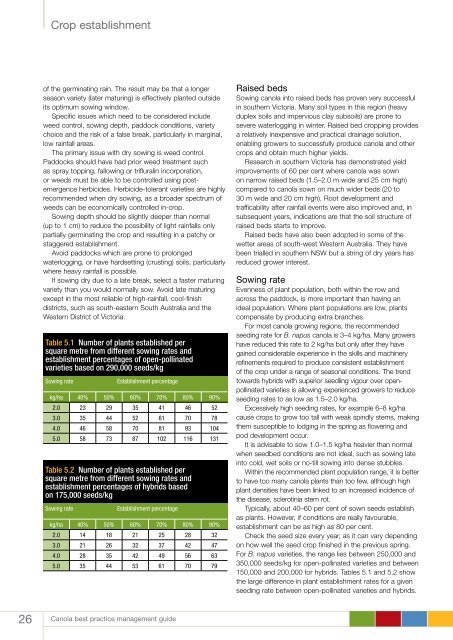best practice management guide for south-eastern Australia - Grains ...
best practice management guide for south-eastern Australia - Grains ...
best practice management guide for south-eastern Australia - Grains ...
Create successful ePaper yourself
Turn your PDF publications into a flip-book with our unique Google optimized e-Paper software.
Crop establishment<br />
of the germinating rain. The result may be that a longer<br />
season variety (later maturing) is effectively planted outside<br />
its optimum sowing window.<br />
Specific issues which need to be considered include<br />
weed control, sowing depth, paddock conditions, variety<br />
choice and the risk of a false break, particularly in marginal,<br />
low rainfall areas.<br />
The primary issue with dry sowing is weed control.<br />
Paddocks should have had prior weed treatment such<br />
as spray topping, fallowing or trifluralin incorporation,<br />
or weeds must be able to be controlled using postemergence<br />
herbicides. Herbicide-tolerant varieties are highly<br />
recommended when dry sowing, as a broader spectrum of<br />
weeds can be economically controlled in-crop.<br />
Sowing depth should be slightly deeper than normal<br />
(up to 1 cm) to reduce the possibility of light rainfalls only<br />
partially germinating the crop and resulting in a patchy or<br />
staggered establishment.<br />
Avoid paddocks which are prone to prolonged<br />
waterlogging, or have hardsetting (crusting) soils, particularly<br />
where heavy rainfall is possible.<br />
If sowing dry due to a late break, select a faster maturing<br />
variety than you would normally sow. Avoid late maturing<br />
except in the most reliable of high-rainfall, cool-finish<br />
districts, such as <strong>south</strong>-<strong>eastern</strong> South <strong>Australia</strong> and the<br />
Western District of Victoria.<br />
Table 5.1 Number of plants established per<br />
square metre from different sowing rates and<br />
establishment percentages of open-pollinated<br />
varieties based on 290,000 seeds/kg<br />
Sowing rate<br />
Establishment percentage<br />
kg/ha 40% 50% 60% 70% 80% 90%<br />
2.0 23 29 35 41 46 52<br />
3.0 35 44 52 61 70 78<br />
4.0 46 58 70 81 93 104<br />
5.0 58 73 87 102 116 131<br />
Table 5.2 Number of plants established per<br />
square metre from different sowing rates and<br />
establishment percentages of hybrids based<br />
on 175,000 seeds/kg<br />
Sowing rate<br />
Establishment percentage<br />
kg/ha 40% 50% 60% 70% 80% 90%<br />
2.0 14 18 21 25 28 32<br />
3.0 21 26 32 37 42 47<br />
4.0 28 35 42 49 56 63<br />
5.0 35 44 53 61 70 79<br />
Raised beds<br />
Sowing canola into raised beds has proven very successful<br />
in <strong>south</strong>ern Victoria. Many soil types in this region (heavy<br />
duplex soils and impervious clay subsoils) are prone to<br />
severe waterlogging in winter. Raised bed cropping provides<br />
a relatively inexpensive and practical drainage solution,<br />
enabling growers to successfully produce canola and other<br />
crops and obtain much higher yields.<br />
Research in <strong>south</strong>ern Victoria has demonstrated yield<br />
improvements of 60 per cent where canola was sown<br />
on narrow raised beds (1.5–2.0 m wide and 25 cm high)<br />
compared to canola sown on much wider beds (20 to<br />
30 m wide and 20 cm high). Root development and<br />
trafficability after rainfall events were also improved and, in<br />
subsequent years, indications are that the soil structure of<br />
raised beds starts to improve.<br />
Raised beds have also been adopted in some of the<br />
wetter areas of <strong>south</strong>-west Western <strong>Australia</strong>. They have<br />
been trialled in <strong>south</strong>ern NSW but a string of dry years has<br />
reduced grower interest.<br />
Sowing rate<br />
Evenness of plant population, both within the row and<br />
across the paddock, is more important than having an<br />
ideal population. Where plant populations are low, plants<br />
compensate by producing extra branches.<br />
For most canola growing regions, the recommended<br />
seeding rate <strong>for</strong> B. napus canola is 3–4 kg/ha. Many growers<br />
have reduced this rate to 2 kg/ha but only after they have<br />
gained considerable experience in the skills and machinery<br />
refinements required to produce consistent establishment<br />
of the crop under a range of seasonal conditions. The trend<br />
towards hybrids with superior seedling vigour over openpollinated<br />
varieties is allowing experienced growers to reduce<br />
seeding rates to as low as 1.5–2.0 kg/ha.<br />
Excessively high seeding rates, <strong>for</strong> example 6–8 kg/ha<br />
cause crops to grow too tall with weak spindly stems, making<br />
them susceptible to lodging in the spring as flowering and<br />
pod development occur.<br />
It is advisable to sow 1.0–1.5 kg/ha heavier than normal<br />
when seedbed conditions are not ideal, such as sowing late<br />
into cold, wet soils or no-till sowing into dense stubbles.<br />
Within the recommended plant population range, it is better<br />
to have too many canola plants than too few, although high<br />
plant densities have been linked to an increased incidence of<br />
the disease, sclerotinia stem rot.<br />
Typically, about 40–60 per cent of sown seeds establish<br />
as plants. However, if conditions are really favourable,<br />
establishment can be as high as 80 per cent.<br />
Check the seed size every year, as it can vary depending<br />
on how well the seed crop finished in the previous spring.<br />
For B. napus varieties, the range lies between 250,000 and<br />
350,000 seeds/kg <strong>for</strong> open-pollinated varieties and between<br />
150,000 and 200,000 <strong>for</strong> hybrids. Tables 5.1 and 5.2 show<br />
the large difference in plant establishment rates <strong>for</strong> a given<br />
seeding rate between open-pollinated varieties and hybrids.<br />
26 Canola <strong>best</strong> <strong>practice</strong> <strong>management</strong> <strong>guide</strong>

















